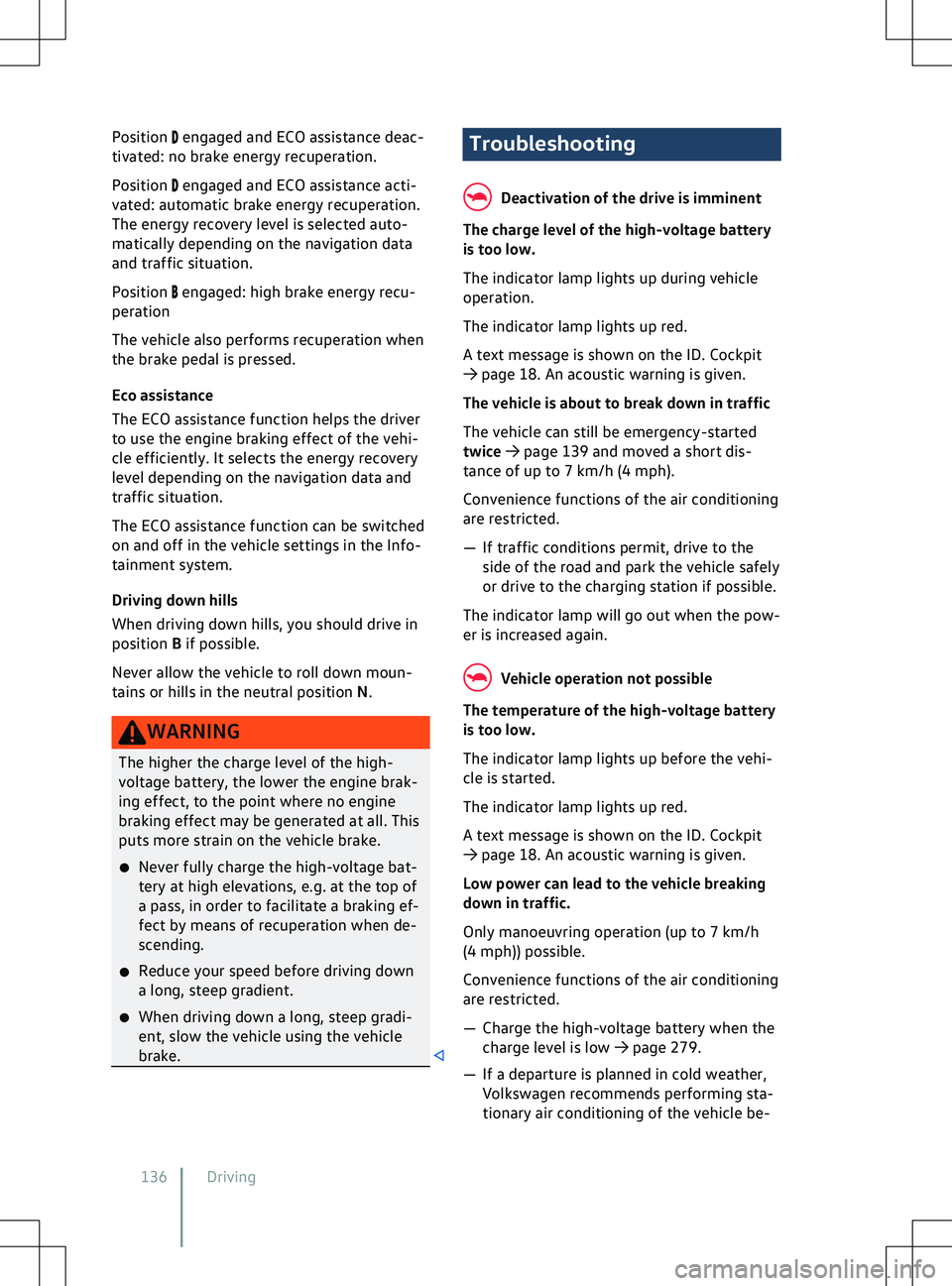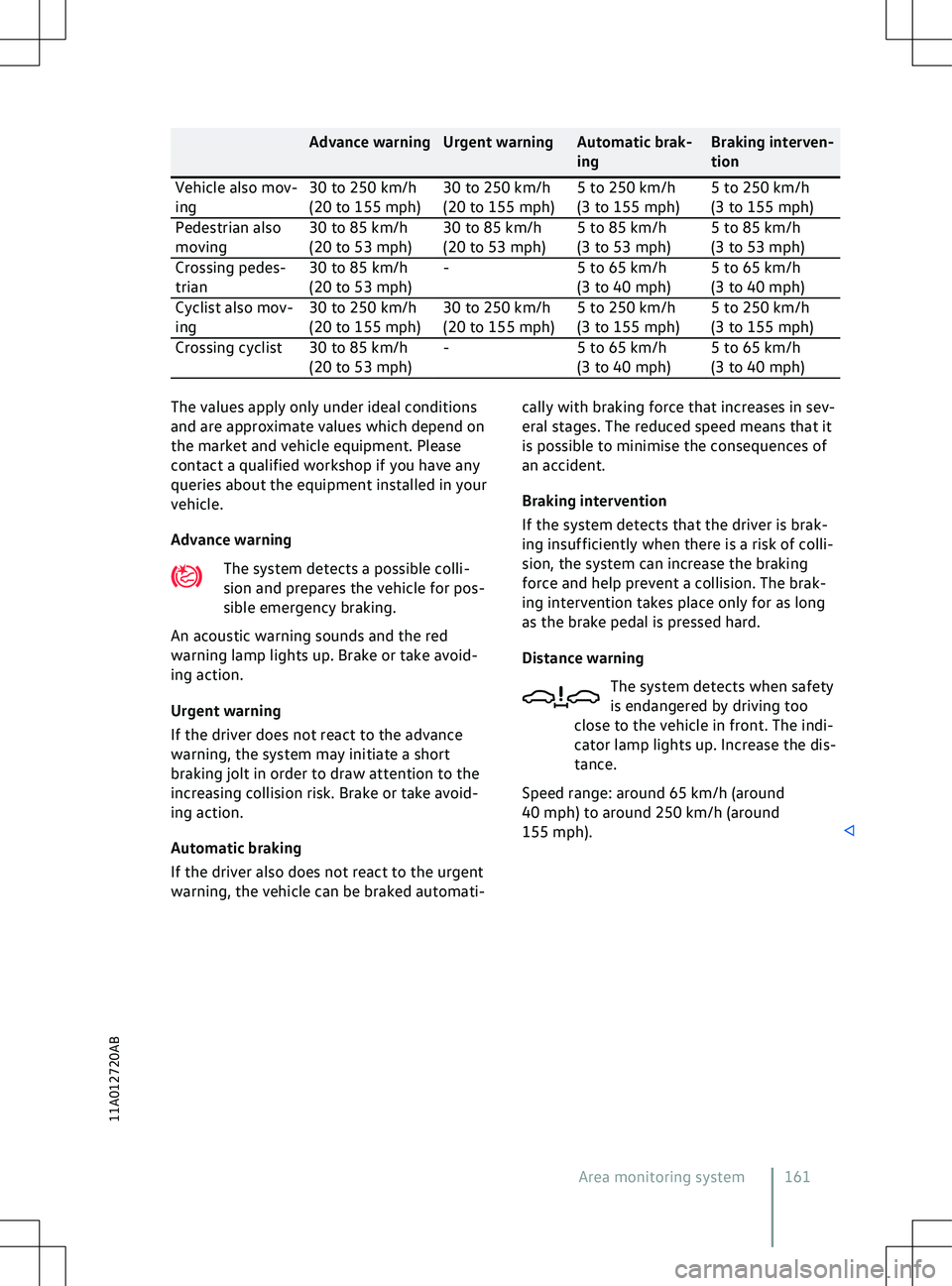Page 138 of 417

Position engaged and ECO assistance deac-
tiv
ated: no brake energy recuperation.
Position engaged and ECO assistance acti-
v
ated: automatic brake energy recuperation.
The energy recovery level is selected auto-
matically depending on the navigation data
and traffic situation.
Position engaged: high brake energy recu-
peration
The v
ehicle also performs recuperation when
the brake pedal is pressed.
Eco assistance
The ECO assistance function helps the driver
to use the engine braking effect of the vehi-
cle efficiently. It selects the energy recovery
level depending on the navigation data and
traffic situation.
The ECO assistance function can be switched
on and off in the vehicle settings in the Info-
tainment system.
Driving down hills
When driving down hills, you should drive in
position B if possible.
Never allow the vehicle to roll down moun-
tains or hills in the neutral position N. Troubleshooting
Deactivation of the drive is imminent
The charge level of the high-voltage battery
is too low.
The indicator lamp lights up during v
ehicle
operation.
The indicator lamp lights up red.
A text message is shown on the ID. Cockpit
Page 141 of 417
Automatically switching on the side lights
If the headlights are switched on at the time
the ignition is automatically deactiv
ated, the
side lights are switched on either until the
vehicle is locked or for no more than about
15 minutes. Electronic immobiliser
The immobiliser helps to pre
vent the vehi-
cle
Page 145 of 417
sistance when steering in some critical
driving situations. The driv
er must steer the
vehicle at all times. Counter steering assis-
tance does not steer the vehicle. Troubleshooting
Steering fault
The warning lamp lights up or flashes red.
There is a fault in the electromechanical
steering or electronic steering column lock.
Page 149 of 417
2. Swipe to the left or right to select the
desired system.
3.
Press the button.
Troubleshooting
Please refer to at the start of the chap-
ter on page 145. Fault in the cruise control system.
The indicator lamp lights up yellow.
Page 153 of 417

Adaptive Cruise Control
(ACC)
Introduction to the topic
The Adaptive Cruise Control (ACC) main-
tains a constant speed that you ha
ve set.
If the vehicle approaches a vehicle in
front, the ACC automatically adapts the
speed so that a distance you have selec-
ted is maintained.
Does the vehicle have ACC?
The vehicle is equipped with ACC if you can
adjust settings for ACC in the Assist systems
menu in the Infotainment system.
Speed range
You can set the speed between 20 km/h
(15 mph) and the maximum speed.
Driving with ACC
You can override the active ACC system at
any time. Cruise control will be stopped if you
brake. If you accelerate, cruise control will be
interrupted while you are accelerating and
then resumed.
The intervention by the ACC system is less
dynamic when towing a trailer.
Driver intervention prompt
If automatic deceleration by the ACC
system is not sufficient or the system
limits have been reached, the ACC
system will request you to also brake
by a corresponding message on the
instrument cluster. In addition, the
red warning lamp lights up and an
acoustic warning is given. Take over
control of the vehicle and be prepared
to brake.
Radar sensor
ACC detects driving situations using a radar
sensor at the front of the vehicle. The range of the radar sensor is up to approximately
160 m (
around 520 ft). Special driving situations
Please refer to at the start of the chap-
ter on page 151.
Predictiv
e cruise control system
If the vehicle is equipped with the Dynamic
Road Sign Display function and an Infotain-
ment system with navigation, ACC can pre-
dictively adapt the vehicle speed to detected
speed limits and the course of the road ahead
Adaptive Cruise Control 151
11A012720AB
Page 158 of 417
�x
Always set a larger distance in wet or
snowy conditions or when visibility is
poor. Troubleshooting
Please refer to at the start of the chap-
ter on page 151. ACC not available.
The indicator lamp lights up yellow.
Page 163 of 417

Advance warning Urgent warning Automatic brak-
ingBraking interven-
tion
Vehicle also mov-
ing 30 to 250 km/h
(20 to 155 mph)30 to 250 km/h
(20 to 155 mph)5 to 250 km/h
(3 to 155 mph)5 to 250 km/h
(3 to 155 mph)
Pedestrian also
mo ving 30 to 85 km/h
(20 to 53 mph) 30 to 85 km/h
(20 to 53 mph)5 to 85 km/h
(3 to 53 mph)5 to 85 km/h
(3 to 53 mph)
Crossing pedes-
trian 30 to 85 km/h
(20 to 53 mph)-
5 to 65 km/h
(3 to 40 mph)5 to 65 km/h
(3 to 40 mph)
Cyclist also mov-
ing 30 to 250 km/h
(20 to 155 mph)30 to 250 km/h
(20 to 155 mph)5 to 250 km/h
(3 to 155 mph)5 to 250 km/h
(3 to 155 mph)
Crossing cyclist 30 to 85 km/h (20 to 53 mph)-
5 to 65 km/h
(3 to 40 mph)5 to 65 km/h
(3 to 40 mph)The values apply only under ideal conditions
and are appro
ximate values which depend on
the market and vehicle equipment. Please
contact a qualified workshop if you have any
queries about the equipment installed in your
vehicle.
Advance warning
The system detects a possible colli-
sion and prepares the vehicle for pos-
sible emergency braking.
An acoustic warning sounds and the red
warning lamp lights up. Brake or take avoid-
ing action.
Urgent warning
If the driver does not react to the advance
warning, the system may initiate a short
braking jolt in order to draw attention to the
increasing collision risk. Brake or take avoid-
ing action.
Automatic braking
If the driver also does not react to the urgent
warning, the vehicle can be braked automati- cally with braking force that increases in sev-
eral stages. The reduced speed means that it
is possible to minimise the consequences of
an accident.
Braking interv
ention
If the system detects that the driver is brak-
ing insufficiently when there is a risk of colli-
sion, the system can increase the braking
force and help prevent a collision. The brak-
ing intervention takes place only for as long
as the brake pedal is pressed hard.
Distance warning
The system detects when safety
is endangered by driving too
close to the vehicle in front. The indi-
cator lamp lights up. Increase the dis-
tance.
Speed range: around 65 km/h (around
40 mph) to around 250 km/h (around
155 mph). Area monitoring system 161
11A012720AB
Page 164 of 417
Limits of Front Assist
Please refer to at the start of the chap-
ter on page 159.
F
ront Assist is not available or its
functions are restricted immediately
after the vehicle is started. The indi-
cator lamp lights up in the instrument
cluster display during this time.
Front Assist has physical and system-related
limitations. You should therefore always be
prepared to take full control of the vehicle if
necessary.
Delayed response
If the camera or radar sensor is exposed to
environmental conditions that impair func-
tioning, the system may detect this only after
a certain delay. For this reason, any restric-
tions to functions may be displayed only after
a delay at the start of the journey and when
driving